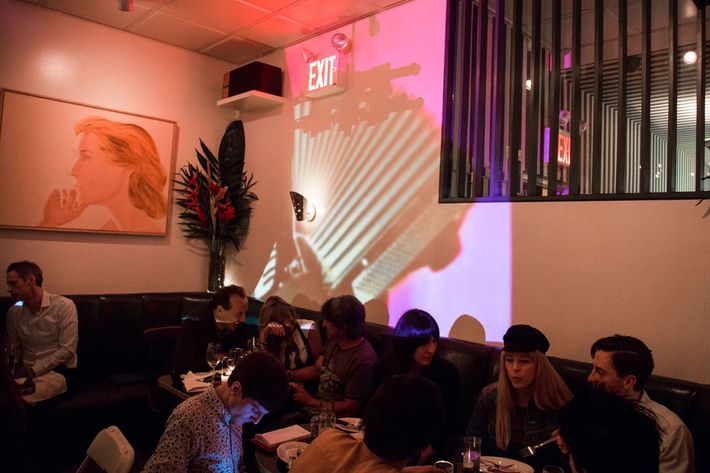
On May 19, artist, fashion designer, and glorious weirdo about downtown Maripol hosted a screening of the new high-definition version of Downtown 81, the film that she made with Glenn O’Brien and Edo Bertoglio that starred Jean-Michel Basquiat as a version of himself — an artist who wanders through that then-gritty part of the city after he finds himself evicted and penniless. The party was at Happy Ending, despite the fact that Basquiat didn’t come to one, but whoever is still around from that scene three decades later has reason enough to feel nostalgic. The DJs at the after-party only played songs from the year 1981 to keep the mood going.
Always fascinated by this mystical land of 1981 — with its legends of cheap rent and the hoary tales of good times — we decided to do some research and ask everyone about it to see what it was really like back then.
“We had a lot of freedom,” says Maripol. “Even if you had a steady boyfriend, you always had lovers, and it was a great moment of freedom because it was before AIDS, and you didn’t think then just the mere fact of making love or making children could bring you to death, and the rent was cheap, and so you could create.”

So, again … just how much were rents back then?
“I actually had a big rent because I moved to a big loft from uptown, so I was paying almost $1,000.”
Of course, you’re lucky if you can find a grubby share in East Williamsburg — more or less today’s “downtown”— on Craigslist for that little these days, but we digress.
Bethann Hardison, one of the first African-American supermodels and founder of Bethann Management Agency, only paid around $600 a month for her Gramercy Park East two-bedroom, two-bathroom apartment. Michael Holman, who starred in the film and played in the industrial band Gray with Basquiat and Vincent Gallo, remembers paying about $500 a month for his apartment on East 14th between avenues A and B. Stephen Torton, Basquiat’s former assistant who created his famous stretched canvases, only paid $200 a month for a two-bedroom apartment on East 7th Street at Avenue C. Jo Shane, an artist whose sculptures were in the fashion-show scene of the film, paid $400 a month for an almost-2,000-square-foot loft.
“Nobody had any clue that this would be the capital of capital,” says Holman. “People were running from New York. It was super crime, everything was broken down, but we liked it that way.”
But with the stakes lower and the non-weirdos afraid to come here, “culture” was clearly bubbling up in the ’80s. It was cheap enough to have fun here. Even if no one could have predicted that this drug-addicted scrawny punk kid they cast to star in Downtown 81 would go on to paint works that would be sold for tens of millions and included in the collection of the Whitney — or that the Whitney would be in the hooker-filled, gay-sex-cruising mecca of the Meatpacking District!
One of Maripol’s less enviable work duties on the set of the film was to wake up the slumbering Basquiat, who straight-up lived in the production offices.
“Sometimes he only had two hours’ sleep, and he was in a really terrible mood,” she recalled.
The film would be in limbo for years. After Basquiat’s death, Maripol needed to find someone to dub in the late Basqiuat’s voice, and while frantically searching for a suitable vocal double, she had a vision of the artist Saul Williams telling her to hire him.
Williams said that the spirit of Basquiat took over his body.
“Glenn O’Brien and all those cats were there, and they couldn’t figure out what he said because he improvised his parts, and that maybe I’d be able to understand what he said,” Williams says. “I heard his voice, so the first word I heard was ‘boom,’ and when I said, ‘Boom!,’ they all started crying, and they said, ‘Yes, that’s what he would say when he would greet people.’” The film premiered in Cannes in 2000.
And what did they remember about Basquiat?
“He was the most entrepreneurial, organized, conscious, ambitious human being I ever met,” said Torton.
“Once he set off a stink bomb in one of his gallerist’s openings because he wasn’t happy with the way he was being treated,” recounted Shane.
“Jean-Michel would go to my house and laugh at me because I never kept updated equipment, so everything I had was so behind the times,” said Hardison.
“We performed at Leo Castelli’s birthday party and Jean-Michel played this machine that you plug in — it scared Leo Castelli almost half way to death,” recounted Holman.
After a few hours of drinking like it was the ’80s, Maripol, who was topless for some reason, ushered me to the bathroom for a chat.
“I throw the best party in town in years! Correct?” she asks me.
Yes, I nodded. “This is the closest to the ’80s, and they said that I have to put my shirt on because I was in my bra,” she went on, still in the bathroom, still shirtless. “I’m so hot out there. The guard, he said, ‘I’m going to throw you out!’ I said, ‘Call the owner before you throw me out!’ They have no idea who is who and what is what.”

